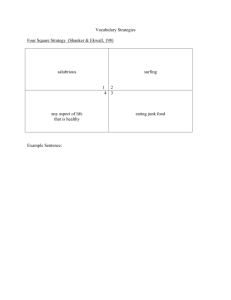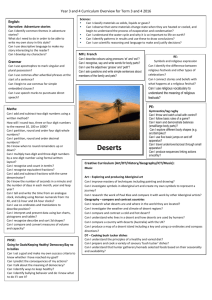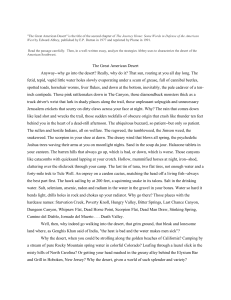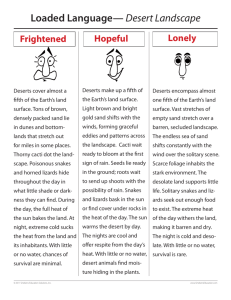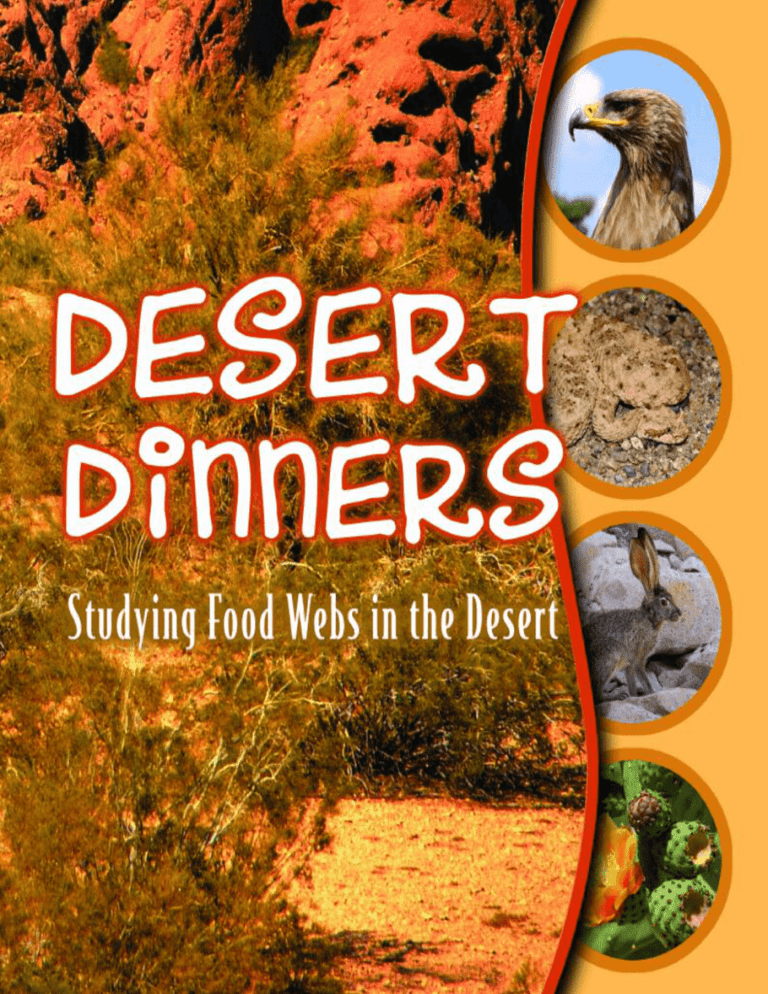
STUDYING FOOD WEBS
Julie K. Lundgren
© 2009 Rourke Publishing LLC
All rights reserved. No part of this book may be reproduced or utilized in any form or by any means,
electronic or mechanical including photocopying, recording, or by any information storage and retrieval
system without permission in writing from the publisher.
www.rourkepublishing.com
Project Assistance:
The author thanks Yajaira Gray from the Center for Sonoran Desert Studies at the Arizona-Sonora Desert
Museum, Tracy Nelson Maurer, and the team at Blue Door Publishing.
Photo credits:
Cover Photos: Eagle © HTuller, Snake © Casey K. Bishop, Rabbit © IRC, Flower © Lee & Marleigh Freyenhagen;
Page 4 © Chris Curtis; Page 5 © Galyna Andrushko, Chris Curtis, Petrov Andrey, Casey K. Bishop, Page 6 © NASA Earth
Observatory; Page 8 © Flominator, Infrogmation, ToB, vera bogaerts; Page 9 © Jarno Gonzalez Zarraonandia; Page 10 ©
douglas knight, PSHAW-PHOTO, Y6y6y6; Page 11 © MWaits, US NPS; Page 12 © Petrov Andrey; Page 13 ©
RTimages, John Hill, Vrlpep; Page 14 © HTuller; Page 15 © Martyman, KeresH (wiki), Berichard; Page 17 © Eric Lawton,
HTuller, urosr, Snowleopard1, Vrlpep, Buquet, TZajaczkowski, Rex, IRC, Brian Weed, MWaits, PSHAW-PHOTO, Steffen
Foerster Photography, Galyna Andrushko, Bertrand Collet, Sebastian Kaulitzki; Page 18 © Rex; Page 19 © PhotoSky 4t
com, Page 19b © Dr. Heinz Linke; Page 20 © Paul Cowan; Page 21 © nialat; Page 22 © Peter Leahy; Page 23 © catnap,
Lou Oates; Page 24 © Stephen Finn; Page 25 © MPF; Page 26 © erikdegraaf fotografie; Page 27 © Nick Carver
Photography; Page 28 © Oleksandr Koval; Page 29 © photoBeard
Editor: Jeanne Sturm
Cover and page design by Nicola Stratford, Blue Door Publishing
Library of Congress Cataloging-in-Publication Data
Lundgren, Julie K.
Desert dinners : studying food webs in the desert / Julie K. Lundgren.
p. cm. -- (Studying food webs)
ISBN 978-1-60472-315-1 (hardcover)
ISBN 978-1-60694-912-2 (softcover)
1. Desert ecology--Juvenile literature. 2. Food chains (Ecology)--Juvenile
literature. 3. Deserts--Juvenile literature. I. Title.
QH541.5.D4L86 2009
577.54'16--dc22
Printed in the USA
CG/CG
www.rourkepublishing.com – rourke@rourkepublishing.com
Post Office Box 3328, Vero Beach, FL 32964
1
On The Cover
Table Of Contents
Harnessing the Sun
4
What’s for Dinner? Desert Dining
10
Moving On Up
16
Breaking It Down
20
Upsetting the Balance
22
Desert Invaders
24
Glossary
30
Index
32
Golden eagles in deserts prey on
rabbits and snakes.
Venomous rattlesnakes eat
small animals.
Jackrabbits nibble on grasses,
seeds, and desert fruits.
Cacti provide food for
desert herbivores.
HEW ON THI
C
All living things need sun,
water, air, and food. A food
chain links living things, each
eaten by the one that follows it.
Food chains begin with sunlight
shining on green plants.
Through photosynthesis,
green plants transform the
Sun’s energy into food for living
and growing. This food energy
passes on to animals when the
plants are eaten, and again
when the animals are eaten.
Because each living thing
plays a role in many food
chains, scientists call all of
the food chains in an area a
food web. The animals
and plants in a food web
depend on each other
for survival.
S
Harnessing the Sun
During the brief days of moisture after a rare
rainfall, North America’s Sonoran Desert
explodes with flowers. Desert plants jump
into action when water is available.
Chlorophyll spurs the
chemical reaction transforming light energy into
food during photosynthesis.
It colors the plants
green, too.
4
This diagram shows the flow of a simple food chain, beginning with the Sun’s energy
and ending with an animal.
5
Weaving a Desert Web
A community of plants and animals and the ways they
interact with each other and their surroundings form an
ecosystem. Desert ecosystems cover a third of Earth’s
land. Hot or cold, hilly or flat, sandy or rocky, they all have
one thing in common: deserts receive 10 inches (25
centimeters) or less of rain each year. Plants and animals
must have adaptations to make their home in this
parched habitat. They must have special ways to survive.
Although South America’s Atacama, a cold winter desert, sits next to
the Pacific Ocean, it receives the least amount of moisture of any
place on Earth.
6
The Arctic and Antarctic form vast frozen
polar deserts. The ice there has
stockpiled over thousands of years.
Most people know about hot deserts,
like the Sahara in northern Africa.
Arctic Ocean
EUROPE
NORTH
AMERICA
AFRICA
Pacific
Ocean
ASIA
Atlantic
Ocean
Indian
Ocean
SOUTH
AMERICA
Pacific
Ocean
Equator
AUSTRALIA
Southern Ocean
ANTARCTICA
Hot deserts circle Earth near its middle, while cold deserts are found in
regions away from the equator.
7
Floating, microscopic organisms
like diatoms and protozoa
support throngs of tiny krill.
Krill support many animals,
like Adelie penguins.
Adelie penguins guard their
chicks and eggs from Antarctic
skuas, another kind of bird.
8
Sizzling days and brrr cold nights
challenge the plants and animals in hot
deserts. Daytime temperatures climb to
120° Fahrenheit (49° Celsius) and plunge to
near freezing after sunset. The dry,
cloudless air allows the day’s heat to escape
out into space.
Cold deserts can be cold winter deserts
or polar deserts. The polar deserts, found in
the Arctic and Antarctic, are deserts of ice
and extreme cold. Harsh conditions limit
life here. Cold winter deserts support
simple food chains of plants and animals
that can withstand the seasonal changes
in temperature.
Like a fanciful dream, a desert oasis springs
up around a water source, supporting its own
unique ecosystem.
S
C
HEW ON THI
El Azizia in Libya holds the
record for the hottest
temperature on Earth: 136°
Fahrenheit (58° Celsius).
Death Valley in California’s
Mojave Desert finishes
second with a high of 134°
Fahrenheit (57° Celsius).
9
What’s for Dinner?
Desert Dining
Transformers!
Plants, the primary producers,
power up the desert ecosystem.
The ability to store lots of water
makes succulents like cacti,
yuccas, and agaves suited to dry
climates. Succulents have a waxy
coating to keep them from drying
out. Their barbed or sharp leaves
protect against hungry (and
thirsty) critters. Shrubs and
grasses grow here, too. Desert
plants have deep or wide root
systems, or their seeds may
simply wait for rain before
sprouting.
S
C
HEW ON THI
Photosynthesis occurs in
cactus stems, while their
leaves take the shape of
sharp spines.
10
Yucca leaves resemble a
bouquet of slicing swords.
This lone creosote bush’s
roots suck up all available
water, leaving nothing for
other plants attempting to
grow near it.
The sharp barbs of agave
leaves deflect plant eaters.
The Sonoran Desert’s giant
saguaro cacti attract insects,
birds, and bats with their
juicy branches, sweet fruit,
and flower nectar.
11
Hunters and Gatherers
Herbivores, the primary consumers, nibble seeds,
cacti, fruits, flower nectar, roots, green leaves, and grasses.
Jerboas, kangaroo rats, and other rodents hide in their
burrows by day and feed under the cool protective
darkness of night. Jackrabbits, grasshoppers, ants, large
herbivores, and others get most of the water they need
from the plants they eat.
This nocturnal jerboa hops
like a kangaroo. Its long back
feet help it dig for roots,
make a burrow, and pour on
the speed when a hungry fox
pursues it. Why do so many
desert animals hop? Hopping
uses less energy than walking
or running.
12
S
C
HEW ON THI
Fruit eaters do plants a favor
by spreading the plant’s
seeds in their scat, or waste.
Carnivores hunt other
animals. Those who eat
primary consumers are
secondary consumers.
Common secondary
consumers include many
creepy crawlies, roadrunners,
and bats. The giant desert
centipede devours any animal
it can overpower. It grows up
The addax, a rare African antelope, can
to 8 inches (20 centimeters)
go months between drinks of water.
long. Scorpions sting insects
and millipedes with their
venomous tails. Tarantulas prey on rodents, lizards, and
small snakes. Shy rattlesnakes favor rodents. Omnivores
like coyotes and foxes take advantage of the whole buffet:
animals, plants, fruits, eggs, and insects. It’s all game.
This giant desert centipede’s body
colors make it hard for another
predator to decide which end is the
head and which is the tail, allowing it a
chance to escape.
Fennecs, found in North Africa and the
Middle East, snap up anything the
desert is serving that day: beetles, small
lizards, rodents, roots, and eggs.
13
The desert ecosystem supports a
few top predators. Eagles, hawks, and
owls patrol the skies, while snow
leopards, wolves, or bobcats prowl
the land. These food chain kings
must search wide areas to find
enough food to survive.
Golden eagles can be found in the deserts, mountains, and
grasslands of North America, Asia, and North Africa, using
their keen eyesight to zero in on prey.
14
Eye On Australia
Amazing animals survive in
Australia’s wild interior. Red
kangaroos are built to hop with long
back feet and strong legs. By
working together, clever dingoes
occasionally nab these “big reds”.
Patient thorny devil lizards flick ants
up one by one with their sticky
tongues. Monitor lizards manage to
swallow thorny devils despite their
protective spikes. People have
brought other animals here. Wild
housecats, camels, and rabbits
compete with native wildlife for
available resources, and sometimes
become dinner themselves.
Desert region
A thorny devil lizard shows its spikes
to predators.
The perentie monitor lizard, also called
the parenty, grows up to 8 feet (2.4
meters) long and weighs up to 33
pounds (15 kilograms). These skillful
carnivores sprint after lizards, snakes,
birds, rabbits, and large insects on their
hind legs.
15
Moving On Up
Food webs describe the energy
transfer from one living thing to
another. Animals and plants are
forms of stored energy. With each
step in the food chain, energy is
passed on and reduced. Plants use
the Sun’s energy to grow stems,
leaves, and roots and to generate
food. Now an herbivore eats the
plants. It uses some of the energy
to grow, but also uses some of the
energy for daily living. When the
herbivore is eaten, again it doesn’t
pass on all of the energy it ate,
only what was stored.
S
C
HEW ON THI
Ecosystems support only a
few top predators, because
of the large numbers of prey
these hunters need to meet
their energy needs. Desert
food chains are short
for efficiency.
16
In a food web, a large
foundation of producers
supports the consumers with
energy from the Sun. As
energy is spent on its way to
the top, fewer animals can be
supplied with enough energy
to meet their needs.
Decomposers recycle food
web waste from all
food levels.
Top Predators
wolves, eagles, other raptors
Secondary Consumers
(Carnivores and Omnivores)
scorpions, snakes, lizards, foxes
Primary Consumers
(Herbivores)
grasshoppers, other insects,
rodents, jackrabbits
Primary Producers (Plants)
Decomposers
beetles, fungi, bacteria
wolves
eagles
snakes &
lizards
scorpions
cacti
rodents
other insects
agaves
beetles
yuccas
fungi
jackrabbits
grasses &
seeds
ENERGY FLOW
grasshoppers
foxes
shrubs
bacteria
17
Food Web Science
Ecologists are scientists
who study ecosystems.
The kangaroo rat packs its cheeks
with seeds, and then digs shallow
holes in which to store them for a
later meal. A forgetful kangaroo rat
helps plants by burying their seeds
and leaving them behind to grow into
new plants.
18
S
HEW ON THI
C
To learn about food webs,
ecologists trek, climb, or dig
to observe living things in
their environment. Because
animals can be tricky to find,
researchers often explore
other ways of learning about
an animal’s diet. By examining
an animal’s scat for undigested
animal or plant parts,
ecologists can identify foods in
its diet. Burrowing animals
sometimes save food for later
in caches. A careful scientist
can find and inventory
these caches.
Ecologists investigate the diet and
habits of each kind of animal to learn
its role in the ecosystem. Using live
traps gives researchers a quick look
at who is in an area and how many.
Field workers trick animals into
entering the traps. They bait the traps
with tasty food and camouflage them.
The workers identify, measure, and
weigh captured animals. They tag or
mark them before release so they’ll
know if they catch them again.
Through this sampling, ecologists
snap a picture of the ecosystem.
19
Breaking It Down
Essential to life on Earth, tiny
bacteria aid decomposition.
Microorganisms work quickest
when it’s warm and damp. That
means things decompose
slowly in deserts, where the air
is dry.
Many human foods would not
be possible without help from
microorganisms. Yeast give off
gas to make bread dough rise.
Bacteria thicken milk to make
yogurt. Cheese makers seed
their creamy blue cheese with
a special fungus for that disSTINK-tive flavor. Friendly
algae stabilize the texture of
ice cream.
20
S
HEW ON THI
C
When plants and animals die,
the energy stored in their bodies
isn’t lost. Scavengers such as
vultures, ravens, and coyotes
help themselves to a free meal of
carrion. Carrion is the bodies of
dead animals. Afterwards,
decomposers quietly dine. These
include millipedes, insects, and
helpful microorganisms like fungi,
mold, and bacteria. They clean
up the leftovers and perform a
valuable service. Decomposers
return necessary nutrients to
the soil to be taken up by
growing plants once again.
It’s nature’s way of recycling!
Turkey vultures feed only on carrion. Their
featherless heads and wide nostrils make it
easier to clean up after gorging on rotten meat.
21
This Joshua tree in the Mojave
Desert supports life in its shade and
branches and feeds bats, birds, and
rodents. If it died, 100 or more
years would pass before another
like it would grow.
Upsetting the Balance
Ecosystems work when
everything is balanced. Removing or
changing one member of a food web
puts all the organisms that depend
on it at risk. Delicate desert
ecosystems contain life that occurs
only under certain conditions,
making them easily harmed.
Unfortunately deserts today face
many threats.
As their numbers increase, people
compete with desert life for the
same limited resources. Cities pump
underground water up to the
surface for people’s daily use. As
cities grow, builders bulldoze deserts
for housing. In more remote areas,
native predators hunt domestic
animals like goats and sheep, and in
turn are hunted by the herders.
22
Recreational vehicles compact fragile soils, cause erosion, and disturb animal burrows.
Developers clear desert land for farming or houses.
23
t
r
e
s
e
D
i n va d e r s !
In deserts, water and food are limited. When a new plant
or animal arrives, it competes with native plants and
animals for local resources. Aggressive invaders replace
native species.
In the 1850s Europeans who had moved to Australia
imported a few rabbits for hunting. The rabbits multiplied
so rapidly that today millions of rabbits ravage farmers’
crops and native plants alike. They burrow in huge
networks of tunnels that replace the burrows of native
animals and cause erosion. The loss of precious topsoil
takes years to rebuild.
Attempts at rabbit
control have been
disappointing and
expensive.
24
Some U.S. ranchers planted buffelgrass, originally
from Africa and Asia, for grazing cattle. Buffelgrass
escaped the pastures and moved into wild desert
nearby. Historically, wide spaces between desert plants
prevented widespread fire. After the invasion,
flammable grass filled those empty areas. Buffelgrass
reseeds itself after a fire, while native plants do not.
25
Global Warming
Global warming is worldwide
climate change. Burning fossil
fuels like coal, oil, and natural
gas releases carbon dioxide, a
greenhouse gas. Greenhouse
gases act like the glass walls of
a greenhouse, trapping the
Sun’s heat in Earth’s
atmosphere. People produce
greenhouse gases when they
drive their cars, produce
electricity, and heat their
homes. As nature’s air
fresheners, plants naturally
take in carbon dioxide and
give off oxygen, but they
cannot keep pace with the
industrial world.
S
C
HEW ON THI
Sonoran Desert scientists have noticed that when
temperatures rise there, they see seasonal winds,
El Niño and La Niña, more often. El Niño brings
more frequent rains while La Niña brings dry spells.
A different climate, one that alternates wet
periods with dry, could result. Climate change could
shift the Sonoran Desert’s ecosystem.
26
Global warming can increase water evaporation and
drought. With less rainfall and more heat, young plants
wither and die. Their immature root systems can’t
handle the lack of water. Flowers stop seed production.
Without food to eat, animals must move on or die.
Without vegetation to anchor them, sand dunes begin to
shift and spread.
27
Desert Survival
Water conservation has importance, too.
Simple ways to save water include
shortening showers, repairing dripping
faucets, and landscaping with native
plants. By reducing the human impact on
Earth, people’s needs become more
balanced with the needs of Earth’s plants
and animals.
28
S
HEW ON THI
C
To help deserts, people can
learn more about them by
reading, asking questions, and
visiting them. Appreciating this
fascinating ecosystem is the first
step in stewardship, or
caretaking. People can combat
global warming by using energy
resources wisely. Small actions
like recycling, carpooling or
taking a bus to school or work,
and remembering to turn off
lights when leaving a room
help in big ways.
Many recycling centers accept
used motor oil, clothing, cereal
boxes, cardboard, phone books,
and magazines in addition to
paper, glass, and cans.
Recycling saves energy and
reduces waste in landfills.
Dramatic and in tune with the environment, native
plantings promote harmony between people and desert life.
29
Glossary
adaptations (ad-ap-TAY-shunz): ways of survival that animals and plants
have to be successful in their environment
caches (KASH-ehz): hiding places in which to store collections of things
decomposers (dee-cum-POH-zerz): animals and plants that cause rot and
decay, enriching the soil with valuable nutrients
ecosystem (EE-koh-sis-tum): the relationships between all the plants and
animals and the place in which they live
erosion (ee-ROH-zhun): the loss of topsoil and with it, the essential
nutrients for growing plants
evaporation (ee-vap-ohr-AY-shun): the change from a liquid to a vapor, or gas
food chain (FOOD CHAYN): a series of plants and animals, each of
which is eaten by the one after it
food web (FOOD WEHB): in an ecosystem, the intricate network
of food chains
native (NAY-tiv): naturally occurring, living in the place where it originated
omnivores (AHM-nuh-vorz): animals that feed on a wide variety of foods
including both plants and animals
photosynthesis (foh-toh-SIN-thuh-siss): the process by which green plants
transform the Sun’s energy into food
primary consumers ( PRYE-mair-ee kahn-SOO-merz): herbivores,
the animals that eat primary producers
primary producers (PRYE-mair-ee proh-DOO-serz): plants that
perform photosynthesis
scavengers (SKAV-ehn-jerz): animals that eat carrion as part or all of their diet
secondary consumers (SEHK-uhn-dair-ee kuhn-SOO-merz): animals
that eat herbivores
succulents (SUHK-yoo-lehnts): plants that can store large amounts of water
30
Further Reading
Hungry for more? Your local library serves up additional information
about desert ecology and food webs. Whet your appetite with these
books and websites.
Books
Aleshire, Peter. Ten of the Most Unusual Deserts. Chelsea House, 2008.
Fleisher, Paul. Desert Food Webs. Lerner, 2007.
Brezina, Corona. Climate Change (In the News). Rosen, 2007.
Websites
Desert USA—The Desert Food Chain
www.desertusa.com/food_chain_k12/kids_1.html
Arizona-Sonora Desert Museum
www.desertmuseum.org/
The Flying Turtle: Exploring Science and Technology Education
www.ftexploring.com/index.html
31
Index
Africa 7, 13, 25
Australia 15, 24
carbon dioxide 26
carnivore 13, 15, 16
climate 10, 26
cold deserts 7, 8
conservation 28
decomposers 16, 20
ecologists 18, 19
ecosystem(s) 6, 9, 10 14, 16,
18, 19, 22, 26, 28
energy 4, 5, 12, 16, 17, 20, 28
erosion 23, 24
food chain(s) 4, 5, 8, 14, 16
About The Author
Julie K. Lundgren grew up near
Lake Superior where she
reveled in mucking about in the
woods, picking berries, and
expanding her rock collection.
Her appetite for learning about
the intricate details of nature
led her to a degree in biology
from the University of
Minnesota. She currently lives
in Minnesota with her husband
and two sons.
32
global warming 26, 27, 28
herbivore(s) 12, 16
invaders 24
live traps 19
microorganisms 20
photosynthesis 4, 10
polar deserts 7, 8
predator(s) 13, 14, 15, 16, 22
prey 13, 14, 16
primary consumers 12, 13, 16
primary producers 10, 16
secondary consumers 13, 16
Sonoran 4, 11, 26
STUDYING FOOD WEBS
This fascinating series of books
teaches the concept of food webs
using amazing photography and
comprehensive text. Each book
highlights a specific habitat and the
animals that live there. Also included
in each book are bolded glossary
words, corresponding glossary, kidfriendly websites, and a detailed index.
TITLES IN THIS SERIES
Arctic Appetizers:
Studying Food Webs in the Arctic
Desert Dinners:
Studying Food Webs in the Desert
Forest Fare:
Studying Food Webs in the Forest
Freshwater Feeders:
Studying Food Webs in Freshwater
Grassland Buffet:
Studying Food Webs in the Grasslands & Savannas
Makers and Takers:
Studying Food Webs in the Ocean


